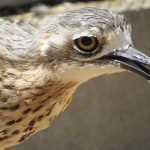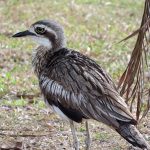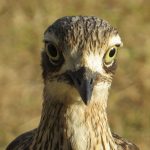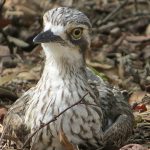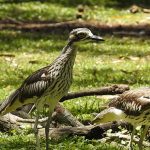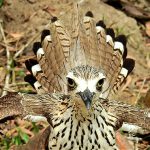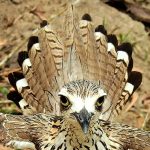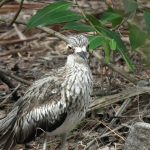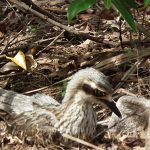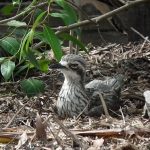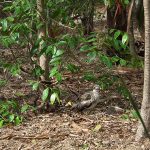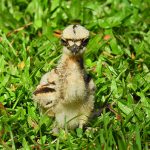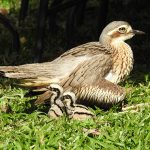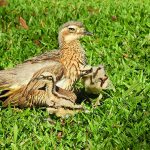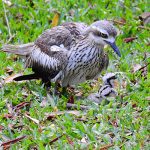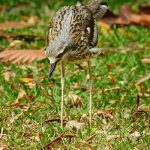BUSH STONE - CURLEW
Burhinus grallarius
Sharon: This ‘Close Encounter’ was filmed from my back door, where I watched on as our friendly, resident Curlews hatched their chicks. A long zoom helped and allowed me to video them without interrupting their parenting. An amazing experience.
Sharon:Our resident Bush Stone-Curlew parents are busy watching over their newly hatched Chicks and begin teaching them to feed. I had an amazing ‘Close Encounter’ as i watched them from afar from my back verandah door. The chicks were so vulnerable and tiny but both parent birds were vigilant in keeping them safe.
The Bush Stone-curlew: Silent Shadows of the Night
A Unique Australian Bird
The Bush Stone-curlew, also known as the Bush Thick-knee or Iben bird, is a remarkable figure in the Australian landscape. Belonging to the family Burhinidae, these medium-sized, ground-dwelling birds are found across diverse regions of Australia, quietly weaving themselves into the fabric of the bush.
Striking Features
Picture a bird cloaked in a tapestry of grey, white, and black feathers. The Bush Stone-curlew stands tall on slender, almost delicate, legs—each step measured and quiet. Its large, yellow eyes seem to glow in the moonlight, capturing the faintest flicker of movement in the dark. A gently curved beak completes its distinctive profile, perfectly adapted for probing the soft earth.
Life Under the Stars
As the sun dips below the horizon and silence settles across the land, the Bush Stone-curlew awakens. Nocturnal by nature, it thrives in the cool of night, a strategy that not only helps it avoid predators but also shelters it from the harsh heat of the day. If you walk softly through grasslands, open woodlands, or along coastal fringes in eastern and northern Australia, you might glimpse these birds—motionless and camouflaged, or gliding quietly through the shadows.
Diet and Hunting
Bush Stone-curlews are opportunistic feeders. Their menu includes:
- Insects: Beetles, grasshoppers, and moths
- Small vertebrates: Frogs, lizards, and occasionally small mammals
- Plant matter: Seeds and fruits when animal prey is scarce
Their method is silent and patient. With a slow, deliberate movement, they stalk their prey, blending seamlessly with their surroundings.
The Haunting Call
Perhaps the most unforgettable aspect of the Bush Stone-curlew is its call. As night deepens, their high-pitched wails and chattering sounds echo across the open spaces—a sound that is both haunting and beautiful, stirring the imagination of anyone who hears it. It is a voice that speaks of the wild heart of Australia, mysterious and ancient.
Family and Nesting
Breeding season brings a quiet determination. Bush Stone-curlews create simple, shallow nests directly on the ground, often hidden amongst tufts of grass or fallen leaves. Typically, two eggs are laid—pale and mottled, blending with the earth. Both parents share the responsibility of incubating the eggs and later, caring for the downy chicks. The sight of a vigilant parent standing guard, eyes alert and feathers ruffled by the breeze, is a testament to their devotion.
Conservation Challenges
| Threat | Impact on Curlews |
|---|---|
| Habitat loss | Reduces nesting and foraging areas |
| Urban development | Fragments their traditional territories |
| Introduced predators | Foxes, dogs, and cats prey on eggs/chicks |
| Livestock trampling | Eggs and nests crushed underfoot |
Once common, Bush Stone-curlew numbers have plummeted over the last century. Now classified as endangered in many regions, their eerie calls grow less frequent each year. Without action, they may vanish within a generation.
Why Their Survival Matters
Bush Stone-curlews are more than a curious bird of the night; they are an indicator of the health of Australia’s open woodlands and grasslands. Their presence signals a balanced ecosystem, where native plants and animals thrive in harmony.
Simple Ways to Support Bush Stone-curlews
1. Leave Fallen Timber on the Ground
- Why it Matters: Fallen branches and logs create essential cover for bush stone-curlews. Their mottled feathers blend perfectly with timber, helping them stay hidden from predators.
- What You Can Do: Resist the urge to tidy up too much. Allow natural debris to remain, creating a protective mosaic across the woodland floor.
2. Manage Grass Height Thoughtfully
- Ideal Conditions: Keep grasses under 15 centimetres high and maintain a sparse cover. This allows curlews to see approaching threats and forage efficiently.
- How to Manage:
- Pulse grazing—allowing animals to graze for short periods followed by rest—can help control grass growth.
- Important Note: Avoid any grazing or mowing during the curlew breeding season (August to January) to prevent disturbing nesting birds and chicks.
3. Conserve and Regenerate Tree Patches
- Preferred Habitat: Curlews thrive where there are both large patches and small clumps of trees, rather than narrow strips or corridors.
- What You Can Do:
- Protect existing groups of trees on your property.
- Encourage natural regeneration by allowing young trees to grow, ensuring habitat for future generations.
- Support habitat conservation: Protecting bushland is vital.
- Responsible pet ownership: Keep cats and dogs restrained, especially near natural areas.
- Raise awareness: Share their story and encourage respect for nocturnal wildlife.
A Lasting Impression
To see a Bush Stone-curlew in the wild is to catch a glimpse of the Australian night—filled with secrets, beauty, and resilience. Their mournful calls remind us of the importance of preserving the quiet magic of nature, not only for future generations but for the health of the planet itself.
Let us listen, learn, and act—so that these silent shadows of the night continue to grace our wild places, their stories woven forever into Australia’s living landscape.

